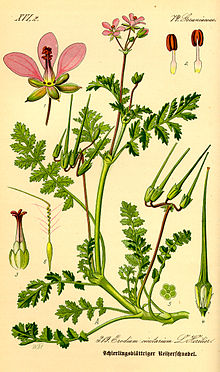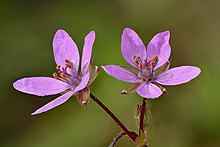| Common stork's-bill | |
|---|---|

| |
| Scientific classification | |
| Kingdom: | Plantae |
| Clade: | Tracheophytes |
| Clade: | Angiosperms |
| Clade: | Eudicots |
| Clade: | Rosids |
| Order: | Geraniales |
| Family: | Geraniaceae |
| Genus: | Erodium |
| Species: | E. cicutarium |
| Binomial name | |
| Erodium cicutarium (L.) L'Hér., 1789 | |
| Synonyms | |
| |
Erodium cicutarium, also known as common stork's-bill, redstem filaree, redstem stork's bill or pinweed, is a herbaceous annual – or in warm climates, biennial – member of the family Geraniaceae of flowering plants. It is native to Macaronesia, temperate Eurasia and north and northeast Africa, and was introduced to North America in the eighteenth century, where it has since become naturalized, particularly of the deserts and arid grasslands of the southwestern United States.
Description
Common stork's-bill is a perennial monoecious herb which typically grows in rosettes pressed flat to the ground, with a deep tap root that allows it to survive through the summer on dry soils. It can develop stems up to 60 cm long which are sometimes red and sometimes green, and may be erect or prostrate, and have simple or glandular hairs which become more abundant towards the top. Plants with glandular hairs are sticky, but those with simple hairs are much less so. It has no scent.
The leaves are arranged in a basal rosette at the beginning of the year, later occurring in opposite pairs along the stem. They are pinnate, almost twice-pinnate as each leaflet is deeply toothed or divided more than halfway to the midrib, and the whole leaf can vary in size from 2–20 cm long, either with a petiole or not. Like the stems, the leaves can be covered with glandular or simple hairs.
The stems bear bright pink flowers which often have dark spots on the bases. The flowers are arranged in a loose cluster and have ten filaments – five of which are fertile – and five styles. The leaves are pinnate to pinnate-pinnatifid, with hairy stems. The long seed-pod, shaped like the bill of a stork, bursts open in a spiral when ripe, sending the seeds (which have long tails called awns) into the air.




Seed dispersal behavior
Erodium cicutarium seed uses self-dispersal mechanisms to spread away from the maternal plant and also reach a good germination site to increase fitness. Two abilities that E. cicutarium has are explosive dispersal, which launches seeds by storing elastic energy, and self-burial dispersal, where the seeds move themselves across the soil using hygroscopically powered shape change.
Explosive dispersal
After flowering, the five pericarps on the fruits of E. cicutarium, and the awns, which are appendages of the pericarps, join and grow into a spine shape. As the fruits dry, dehydration creates tension, and elastic energy develops within the awns. With sufficient elastic energy the shape of the awns changes from straight to helical, causing them to burst away from the maternal plants, bringing the seeds with them. During dispersal, mechanical energy stored in specialized tissues is transferred to the seeds to increase their kinetic and potential energy. The energy storage capacity of the seeds is determined by the level of hydration, suggesting a role of turgor pressure in the explosive dispersal mechanism.
Self-burial dispersal
The awn of each seed, once on the ground, responds to the humidity of the environment and changes its shape accordingly. The awn coils under dehydration and uncoils when wet. This results in motor action of the seed, which, combined with the hairs on the seed and along the length of the awns, moves the seed across the surface, eventually positioning it into a crevice and creating a drilling action that forces the seed into the ground. The coiling and uncoiling of the awns is achieved by the hygroscopic tissue in the active layer on the awns. Hygroscopic movement happens in response to a change in the water content of dead plant tissue, specially in the cell wall. Water absorbed by the cell wall binds to the matrix of the awns, causing it to expand and to drive the cellulose microfibrils apart, which causes the matrix to uncoil, thus straightening the awns. Inversely, the matrix will contract under dehydration, leading to the coil of the awns.
Research found no correlation between weight of the awned fruits and the dispersal distance. E. cicutarium with larger seeds have a longer coil and uncoil time compare to smaller seeds. In the field, the rate of seed burial declined throughout the season. The larger seeds buried themselves more often than the smaller seeds. However, larger seeds have a harder time finding a large enough space for the seeds to be buried. Conversely, smaller seeds have an easier time finding a hole and drilling themselves in, and thus are more likely to be buried.
Advantages
The advantages of explosive dispersal and self-burial dispersal are getting mature seeds of E.cicutarium quickly to the ground during the most favorable period for burial, thus increasing fitness.
Distribution and ecology
Erodium cicutarium has a very extensive native range. It includes all of Europe with the exception of Iceland. In Africa its native range extends across the north from Morocco to Egypt and also in Chad and Eritrea, but not in Sudan. It is also native in most of Asia according to Plants of the World Online with the exceptions of Southeast Asia, central China, and Mongolia. It now grows as an introduced plant in Taiwan, Korea, Japan, and the eastern half of the Russian Far East.
The plant is widespread across North America. It grows as an annual in the continent's northern half. In the southern areas of North America, the plant tends to grow as a biennial with a more erect habit and with much larger leaves, flowers, and fruits. It flowers from May until August. Common stork's-bill can be found in bare, sandy, grassy places both inland and around the coasts. It is a food plant for the larvae of the brown argus butterfly.
The seeds of this plant are collected by various species of harvester ants.
Uses
The young leaves are edible raw or cooked. The whole plant is reportedly edible with a flavor similar to sharp parsley if picked young. According to John Lovell's Honey Plants of North America (1926), "the pink flowers are a valuable source of honey (nectar), and also furnish much pollen". Among the Zuni people, a poultice of chewed root is applied to sores and rashes and an infusion of the root is taken for stomachache.
Nutrition
| Nutritional value per 100 g (3.5 oz) | |||||||||||||||||||||||||||||||||||
|---|---|---|---|---|---|---|---|---|---|---|---|---|---|---|---|---|---|---|---|---|---|---|---|---|---|---|---|---|---|---|---|---|---|---|---|
| Energy | 96 kJ (23 kcal) | ||||||||||||||||||||||||||||||||||
| Carbohydrates | 7.9 g | ||||||||||||||||||||||||||||||||||
| Sugars | 4.3 g | ||||||||||||||||||||||||||||||||||
| Dietary fiber | 3.0 g | ||||||||||||||||||||||||||||||||||
| Fat | 0.1 g | ||||||||||||||||||||||||||||||||||
| Protein | 0.6 g | ||||||||||||||||||||||||||||||||||
| |||||||||||||||||||||||||||||||||||
| Other constituents | Quantity | ||||||||||||||||||||||||||||||||||
| Water | 90.6 g | ||||||||||||||||||||||||||||||||||
| Percentages estimated using US recommendations for adults, except for potassium, which is estimated based on expert recommendation from the National Academies. | |||||||||||||||||||||||||||||||||||
Raw Hairy stork's bill are 90.6% water, 7.9% carbohydrates, 0.6% protein, 3% dietary fiber, 0.8% ash and 0.1% fat.
References
- ^ "Erodium cicutarium (L.) L'Hér". Plants of the World Online. Royal Botanic Gardens, Kew. Retrieved 18 September 2024.
- "Erodium cicutarium", NBN Atlas, retrieved 2022-02-19
- Mensing, Scott; Byrne, Roger (July 1998). "Pre-mission invasion of Erodium cicutarium in California". Journal of Biogeography. 25 (4): 757–762. Bibcode:1998JBiog..25..757M. doi:10.1046/j.1365-2699.1998.2540757.x. S2CID 84221304.
- ^ Stamp, Nancy E. (1984). "Self-burial behaviour of Erodium cicutarium seeds". Journal of Ecology. 72 (2): 611–620. Bibcode:1984JEcol..72..611S. doi:10.2307/2260070. JSTOR 2260070.
- Stace, C.A. (2019). New Flora of the British Isles (4th ed.). Suffolk: C&M Floristics. ISBN 978-1-5272-2630-2.
- Giblin, David. "Erodium cicutarium, redstem stork's bill, common stork's bill". WTU Herbarium Image Collection. Burke Museum of Natural History and Culture. Archived from the original on August 11, 2016. Retrieved October 29, 2013.
- ^ Elias, Thomas S.; Dykeman, Peter A. (2009) . Edible Wild Plants: A North American Field Guide to Over 200 Natural Foods. New York: Sterling. p. 109. ISBN 978-1-4027-6715-9. OCLC 244766414.
- Evangelista, Dennis; Hotton, Scott; Dumais, Jacques (15 February 2011). "The mechanics of explosive dispersal and self-burial in the seeds of the filaree, Erodium cicutarium (Geraniaceae)". Journal of Experimental Biology. 214 (4): 521–529. doi:10.1242/jeb.050567. PMID 21270299.
- ^ Stamp, N. E. (1989). "Seed Dispersal of Four Sympatric Grassland Annual Species of Erodium". Journal of Ecology. 77 (4): 1005–1020. Bibcode:1989JEcol..77.1005S. doi:10.2307/2260819. JSTOR 2260819.
- Hayashi, Marika; Feilich, Kara L.; Ellerby, David J. (May 2009). "The mechanics of explosive seed dispersal in orange jewelweed (Impatiens capensis)". Journal of Experimental Botany. 60 (7): 2045–2053. doi:10.1093/jxb/erp070. PMC 2682495. PMID 19321647.
- Elbaum, Rivka; Abraham, Yael (June 2014). "Insights into the microstructures of hygroscopic movement in plant seed dispersal". Plant Science. 223: 124–133. doi:10.1016/j.plantsci.2014.03.014. PMID 24767122.
- Harmon, G. D.; Stamp, N. E. (1992). "Effects of Postdispersal Seed Predation on Spatial Inequality and Size Variability in an Annual Plant, Erodium cicutarium (Geraniaceae)". American Journal of Botany. 79 (3): 300–305. doi:10.2307/2445019. JSTOR 2445019.
- John H. Lovell (1926). Honey Plants of North America.
- Camazine, Scott; Bye, Robert A. (January 1980). "A study of the medical ethnobotany of the Zuni Indians of New Mexico". Journal of Ethnopharmacology. 2 (4): 365–388. doi:10.1016/S0378-8741(80)81017-8. PMID 6893476.
- ^ Cohen, Shabtai; Koltai, Hinanit; Selvaraj, Gopinath; Mazuz, Moran; Segoli, Moran; Bustan, Amnon; Guy, Ofer (20 August 2020). "Assessment of the Nutritional and Medicinal Potential of Tubers from Hairy Stork's-Bill (Erodium crassifolium L 'Hér), a Wild Plant Species Inhabiting Arid Southeast Mediterranean Regions". Plants. 9 (9): 1069. doi:10.3390/plants9091069. PMC 7570100. PMID 32825348.
- United States Food and Drug Administration (2024). "Daily Value on the Nutrition and Supplement Facts Labels". FDA. Archived from the original on 2024-03-27. Retrieved 2024-03-28.
- National Academies of Sciences, Engineering, and Medicine; Health and Medicine Division; Food and Nutrition Board; Committee to Review the Dietary Reference Intakes for Sodium and Potassium (2019). "Chapter 4: Potassium: Dietary Reference Intakes for Adequacy". In Oria, Maria; Harrison, Meghan; Stallings, Virginia A. (eds.). Dietary Reference Intakes for Sodium and Potassium. The National Academies Collection: Reports funded by National Institutes of Health. Washington, DC: National Academies Press (US). pp. 120–121. doi:10.17226/25353. ISBN 978-0-309-48834-1. PMID 30844154. Retrieved 2024-12-05.
External links
- GRIN-Global Web v 1.9.6.2: Erodium cicutarium — distribution + taxonomy.
- Spice, Byron (15 February 2023). "Engineered Magic: Wooden Seed Carriers Mimic the Behavior of Self-Burying Seeds" (Press release). Carnegie Mellon University.
| Taxon identifiers | |
|---|---|
| Erodium cicutarium |
|
| Geranium cicutarium | |